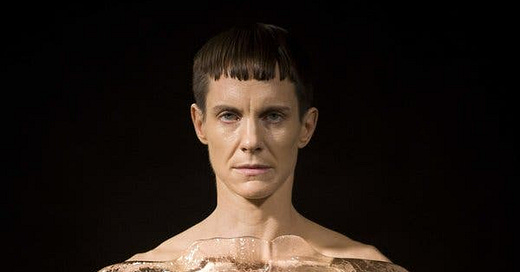Introduction
Cassils is an artist who challenges the very nature of visibility, gender, and identity through performance, sculpture, and activism. Their work is a visceral exploration of endurance, power, and transformation—using their body as both a medium and a battleground. As a transgender, nonbinary artist, Cassils does not just create art; they stage experiences that force audiences to confront the realities of gender, violence, and resilience in ways that are deeply physical and often unsettling.
“I see my body as a material, just like paint or clay…I’m all about self-construction.”
— Cassils
From performances where they sculpt their body in total darkness to public interventions that highlight systemic injustices, Cassils' work is political at its core. They push the limits of human endurance, using pain, strength, and resistance as artistic tools. Their pieces are not simply performances but lived experiences that challenge perceptions of gender and identity, particularly in a world that often seeks to erase or marginalize trans bodies.
Up To and Including Their Limits, 2020
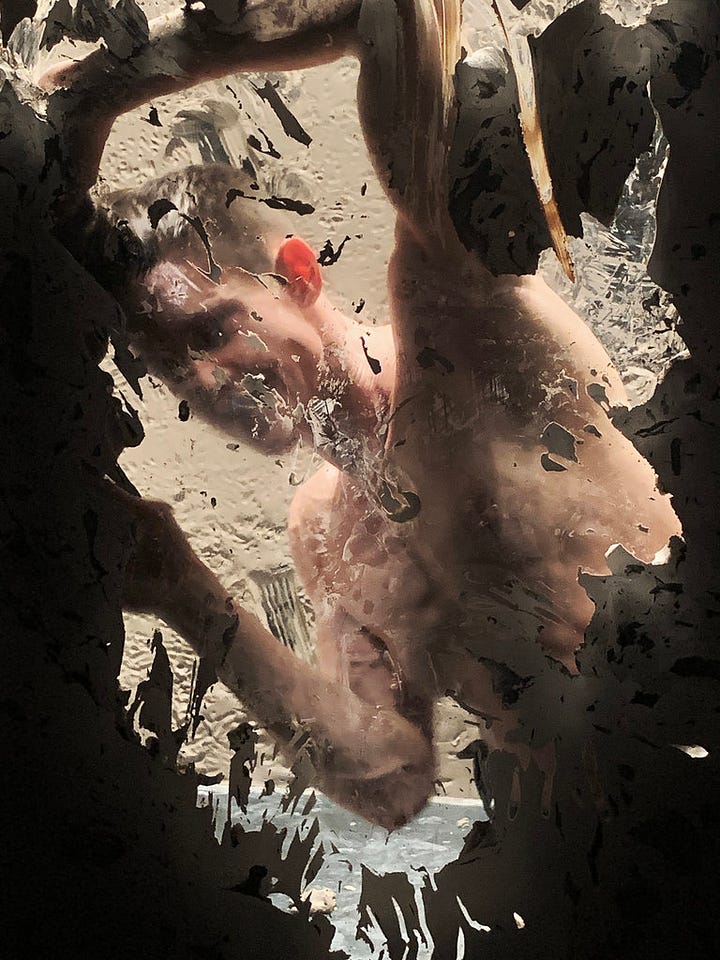
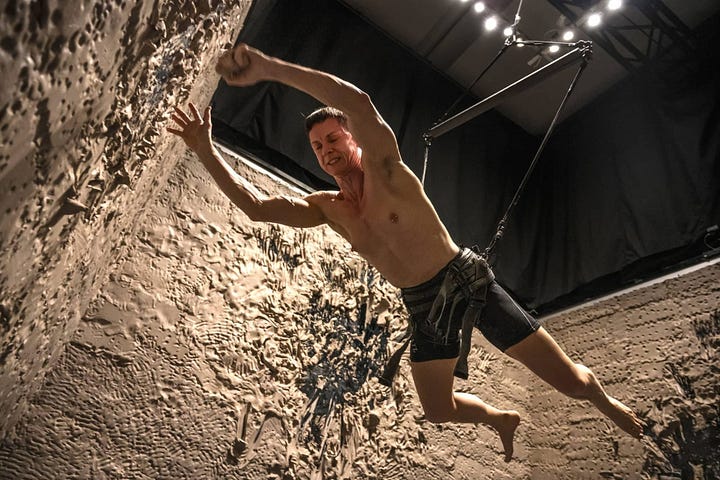
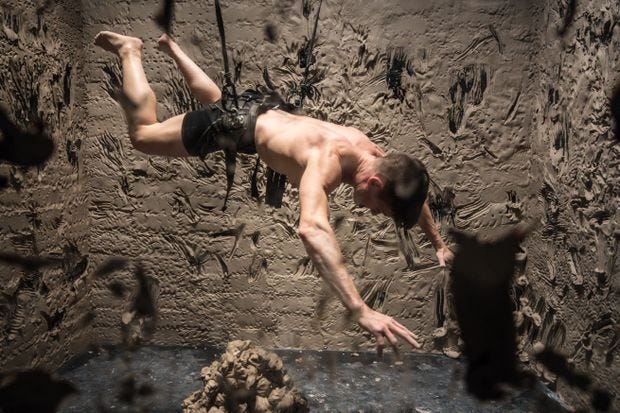
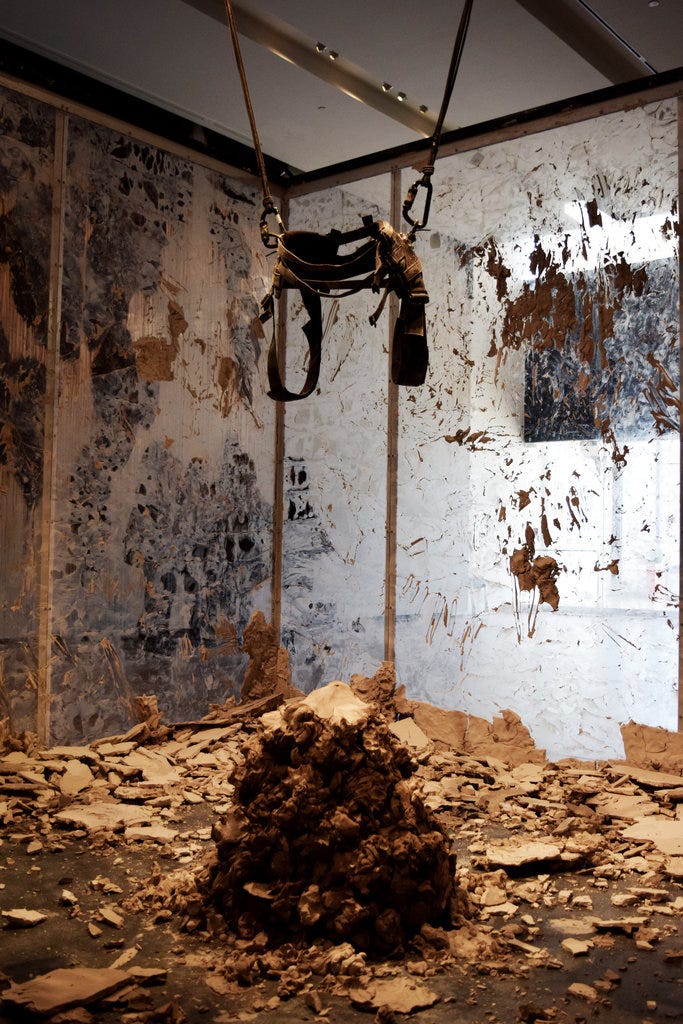
Up To and Including Their Limits debuted at a moment when increased trans visibility was coinciding with growing violence against trans people and challenges to trans rights. Cassils made viewers confront this tension by pushing their body to the brink while a live audience looked on. Suspended from a harness in a plexiglass box with walls covered in thick raw clay, Cassils used their mechanics and equilibrium to launch themself back and forth, clawing, swinging at the walls, and hurling chunks of clay to the floor. As they removed swaths of clay, Cassils created “windows” through which the audience could see the performative action, problematizing and complicating the audience’s gaze by engineering voyeurism into the work itself.
Cassils has gained international recognition for their daring approach, appearing in major exhibitions and performances worldwide. Their work is a reflection of a lifetime spent navigating and resisting societal constraints, turning personal and collective struggles into powerful artistic statements. Through each project, they invite audiences to rethink how bodies—especially trans bodies—are represented, controlled, and liberated.
Early Life and Background
Cultural and Personal Influences
Born in 1975 and raised in Canada, Cassils grew up in a culture that was simultaneously progressive and restrictive when it came to conversations about gender and identity. While Canada is often viewed as a champion of human rights, Cassils still encountered societal expectations that reinforced rigid gender norms. From an early age, they grappled with questions of visibility, bodily autonomy, and self-expression, navigating a landscape that often lacked nuanced discussions about nonbinary and transgender identities. These experiences fueled their desire to explore alternative ways of understanding and representing the human body, leading them toward an artistic practice that challenges conventional ideas of form, beauty, and identity.
Cassils journey began with a childhood diagnosis of a gallbladder disease that stunted their growth.
“I almost died during that period—the doctors opened me up and found out that my organs were rotting. It made me interested in understanding my own body and my mortality. I began to go to the YMCA and weight train at 15 because I was so tiny and weak.”
— Cassils
Cassils has spoken about the ways in which their upbringing shaped their perception of power, particularly in relation to the body and its capacity for transformation. Their early experiences with sports and physical training contributed to their fascination with endurance, discipline, and physical strength—all of which would later become defining aspects of their artistic performances. By engaging with physicality as both a personal and political act, Cassils discovered a way to subvert traditional gender roles, rejecting societal expectations in favor of self-determined identity.

“I came face to face with my mortality at age 14. This got me interested in advocating for my own body and this is how I started learning about the body which in turn led me to a career as a personal trainer. I help people learn about their bodies and be present, healthy and connected in a society that insists upon slumping over your computer, eating fast food and charges you when you get sick. Being an artist, I have always supported myself with my work as a personal trainer. I have run my own business now for 17 years. As I do a lot of both practices and so the two have informed each other over the years.”
— Cassils
These cultural influences are evident in Cassils' work, where themes of resistance, transformation, and reclamation take center stage. Whether through endurance-based performances or sculptural installations, Cassils continuously interrogates how bodies are perceived, controlled, and politicized. By situating their own body at the heart of their practice, they challenge audiences to rethink their assumptions about gender, identity, and power.
Early Exposure to Art and Education
Cassils' formal journey into the art world began at the Nova Scotia College of Art and Design, a school known for its rigorous conceptual art program. Here, they were introduced to a wide range of artistic disciplines, including sculpture, photography, and performance art. The curriculum encouraged interdisciplinary exploration, pushing students to engage critically with their materials and methods. This environment provided Cassils with the tools to experiment with different media, ultimately leading them to develop a unique style that merges physical endurance with visual storytelling. Cassils received their BFA in 1997. Upon graduating, Cassils moved to New York City in 1997, to intern at the Franklin Furnace, where they assisted with the digitization of the archive. In 2000, Cassils left to attend California Institute of the Arts on a merit scholarship, and they received their MFA in 2002.
Through training in disciplines like martial arts, bodybuilding, and endurance-based practices, Cassils developed a unique relationship with their physical form. They saw the body not just as a biological fact but as something that could be sculpted, challenged, and redefined. This approach became central to their artistic practice, as they began exploring themes of transformation—both personal and political—through highly physical performances.
When training for Inextinguishable Fire, Cassils would jog up a hill carrying a backpack filled with watermelons in an effort to improve their breathing control (inhaling at any point during the 14-second performance would char their esophagus). For Becoming an Image, Cassils conditioned their body for impact by taking martial art sessions four times a week for several months before the performance.
Inextinguishable Fire, 2007 - 2015
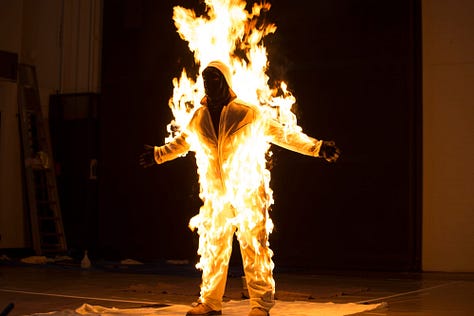
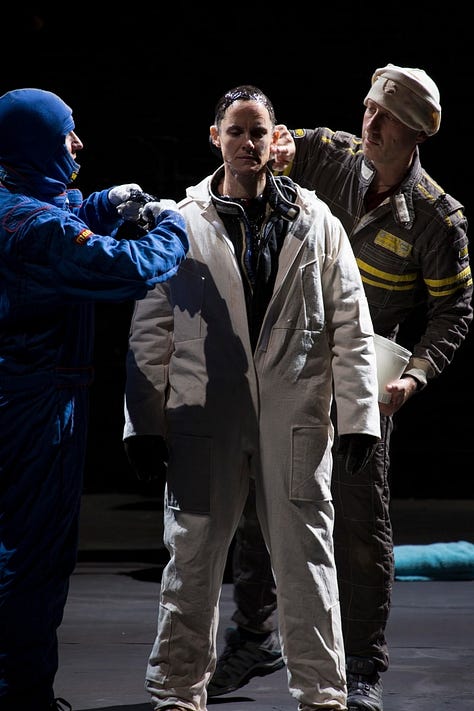
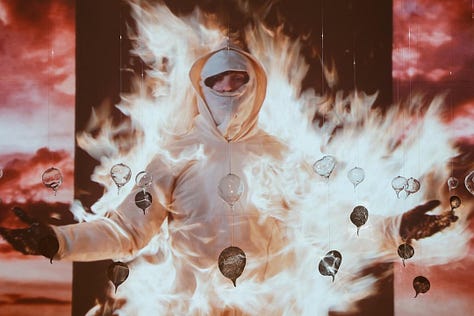
The Inextinguishable Fire performance presented the stark figure of Cassils on stage where a stunt team carefully prepared their body for a full-body burn. Using Hollywood stunt production techniques, the crew laboriously coated the artist’s body in layers of fire resistant long underwear soaked in a freezing solution intended to induce a hypothermic state. The risk in performing a fire stunt is not that the fire will touch the skin but that perspiration from the heat of the body will boil and burn the skin inside of the protective garments. For this reason, Cassils was chilled to the bone before they were lit ablaze. Inextinguishable Fire’s live burn is limited to the length of a single exhalation in order to protect their esophagus. When asked how this piece represented trans politics, this was Cassils’ response:
”My goal is to hopefully ask people to think more critically. When you look at me, you’re not seeing my body, you’re seeing, in this case, an abstracted human form engulfed in flames, and you can place yourself in that position for a moment and think about what it would be like to be subjected to that violence. Thinking about that may change the way you walk through the world.”
— Cassils
Their background in visual art, combined with a deep interest in movement and endurance, led them to create works that are both conceptually rich and physically demanding. Cassils' early experiences with art and activism laid the foundation for a career dedicated to pushing boundaries and reshaping narratives around gender, power, and resilience.
📞Fun Fact: Cassils shared a kiss with Lady Gaga as a prison inmate in Gaga’s Telephone music video
Artistic Influences and Style
Key Influences
Cassils draws inspiration from a variety of sources, including feminist performance artists, queer theorists, and bodybuilders. Artists like Ana Mendieta, Chris Burden, and Ron Athey have had a profound impact on Cassils' approach, particularly in their use of the body as a site of political resistance. Mendieta’s work, which often explored themes of violence, identity, and the body’s relationship to space, resonates with Cassils' interest in endurance and physical transformation. Similarly, Burden’s extreme physical performances, which often placed his body in dangerous or painful situations, have influenced Cassils' commitment to using their own body as a sculptural and political medium.
TIRESIAS, 2011
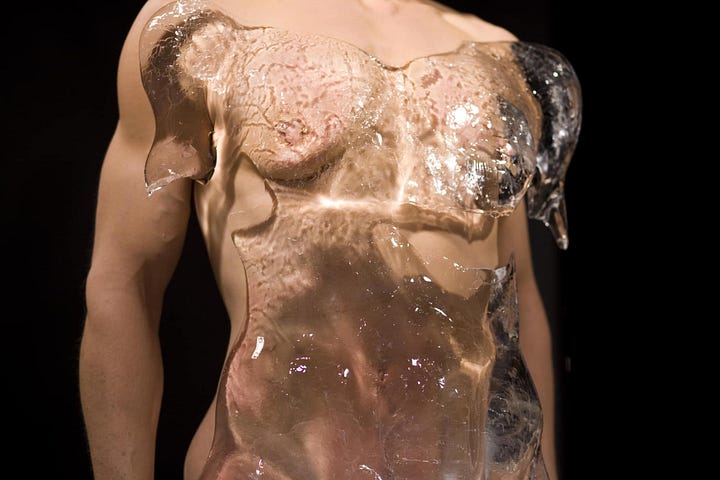
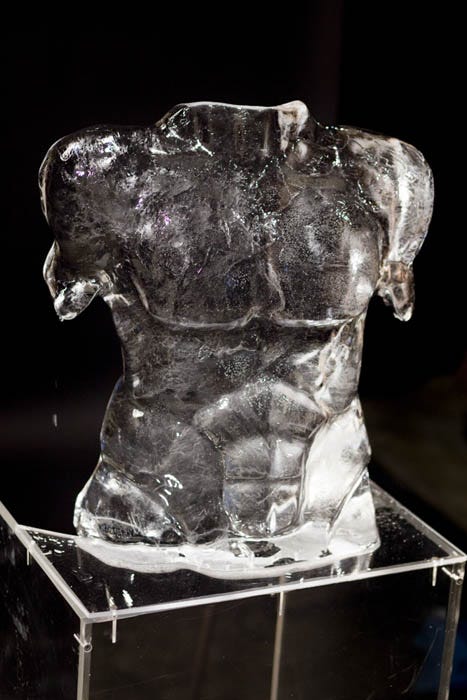
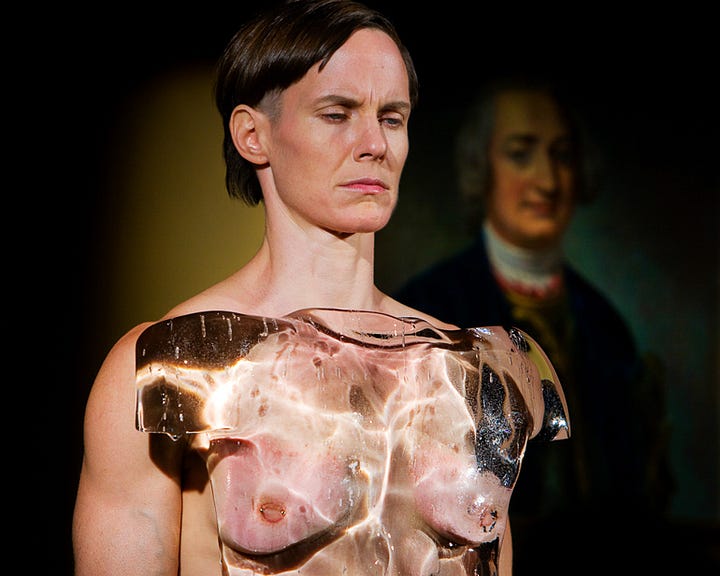
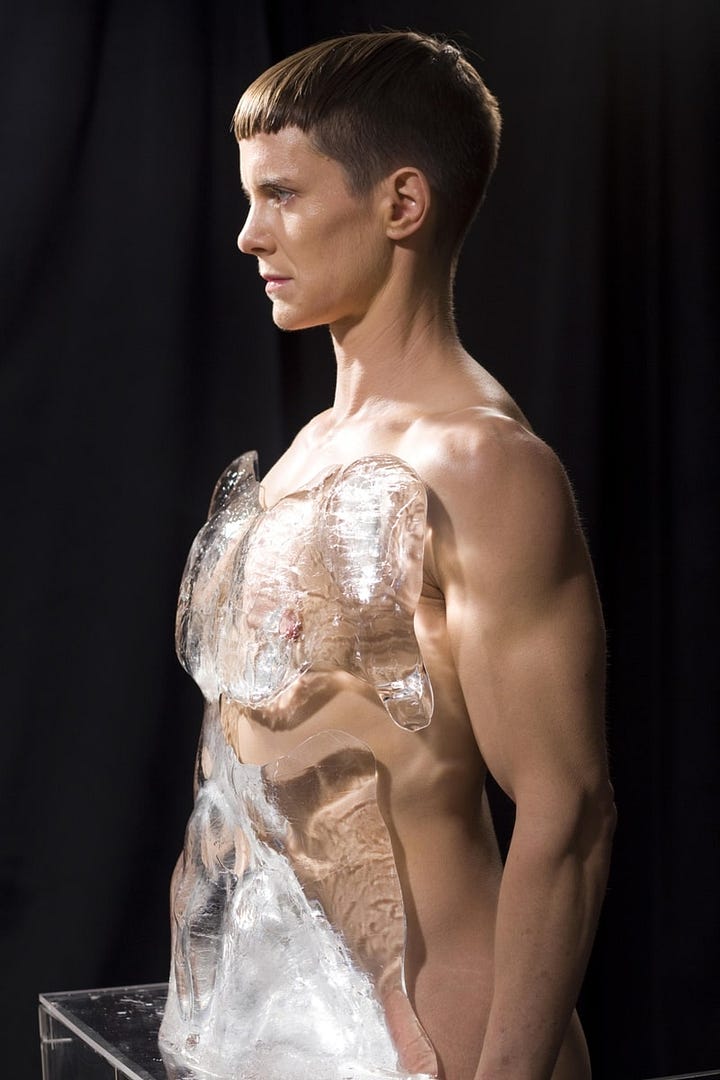
Tiresias is a durational performance in which Cassils melts a neoclassical Greek male ice sculpture with pure body heat.
The mythological figure of Tiresias, known as the blind prophet of Thebes, was transformed from a man into a woman for seven years. By pressing their body against the ice torso, Cassils demonstrates both the instability of the body and desire for a certain unsustainable physique. Recasting the myth of Tiresias as a story of endurance and transformation, Cassils performs the resolve required to persist at the point of contact between masculine and feminine.
Beyond visual art, Cassils' work is also shaped by their background in bodybuilding and martial arts. Trained in stunts, sports medicine and mixed martial arts, they have worked as a semiprofessional boxer, stunts-person, and personal trainer in addition to their career in art. The discipline and physical training required in these fields align with their interest in endurance-based performance. By sculpting their body through intense training regimens, Cassils challenges traditional notions of gender and bodily autonomy, demonstrating that identity is not fixed but rather something that can be actively shaped and performed. This philosophy is reflected in works like CUTS, where they underwent an intensive six-month bodybuilding transformation to critique the ways in which masculinity and strength are constructed in popular culture.
“Bodybuilding is such a cartoon, a hyperperformance of masculinity, I became interested in not necessarily trying to approach this perfect masculinity, but more to play with this false idea of embodiment.”
— Cassils
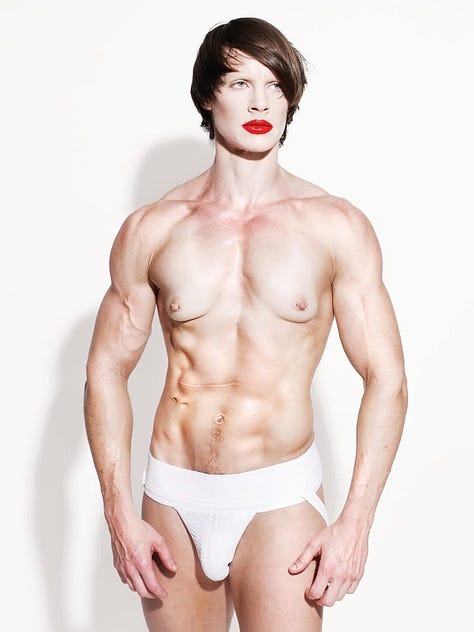
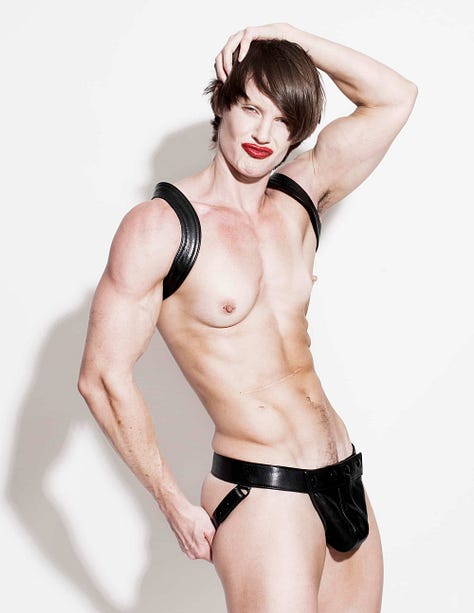

Art + Identity
Identity is at the core of Cassils' artistic practice, particularly as it relates to gender, visibility, and the politics of the body. Their work disrupts binary understandings of gender, instead presenting the body as a site of constant transformation and resistance. Through their performances, Cassils challenges audiences to confront their preconceived notions about identity, urging them to question the ways in which society polices and categorizes bodies.
“Our society has made strides with gender nonconforming people, especially in Canada, but, in all honesty, we’ve just begun having enlightened conversations about being who we truly are.”
— Cassils
One of Cassils’ most striking explorations of identity is Becoming an Image, a performance in which they use their body to strike and mold a massive block of clay in complete darkness. The audience experiences the piece through sound and occasional bursts of light, creating a visceral and immersive engagement with the artist’s physical struggle. This work speaks to the violence and erasure faced by transgender individuals while also asserting the power of the body to create and reclaim space.
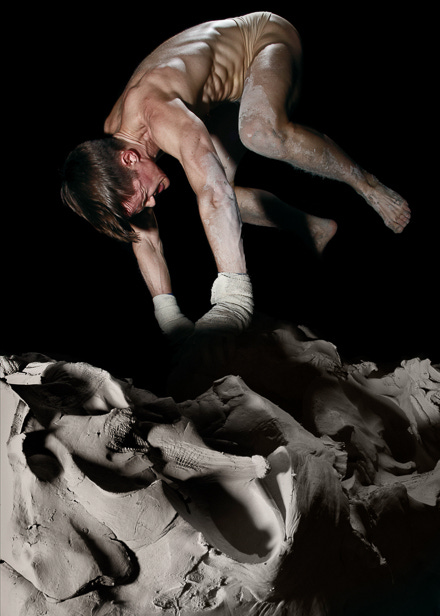
Their approach to identity is not limited to gender alone but extends to broader themes of visibility and representation. In many of their works, Cassils employs strategies that obscure or distort their own form, forcing viewers to engage with presence rather than recognition. By manipulating light, shadow, and perspective, they challenge the notion that identity must always be legible or easily categorized. This refusal to be confined by labels is a radical act of resistance, one that underscores the fluid and constructed nature of identity itself.
Art + Activism
Cassils’ work is deeply intertwined with activism, using performance as a means of political resistance. Many of their pieces address issues such as trans visibility, LGBTQIA2S+ rights, and state-sanctioned violence, turning the body into both a site of protest and resilience. Rather than relying on traditional forms of advocacy, Cassils embeds their activism within the physical and emotional intensity of their performances, making social critique a visceral experience for audiences.
“It is the largest assault historically in the United States, this stance on trans and gender non-conforming people.”
— Cassils
One of the most powerful examples of their activist-driven work is PISSED, a project that involved collecting 200 gallons of urine over a 200-day period to protest the Trump administration’s rollback of protections for transgender individuals. By transforming bodily waste into an artistic statement, Cassils highlighted the absurdity and cruelty of policies that attempt to control and police gender identity. This piece exemplifies their ability to transform personal and political trauma into a bold artistic intervention, forcing audiences to confront the tangible consequences of institutional discrimination.

Cassils’ activism also extends beyond their own performances. They frequently collaborate with other artists, activists, and scholars to create spaces for dialogue and resistance. Their project In Plain Sight was a nationwide initiative involving multiple artists who projected messages into the sky above ICE detention centers, bringing attention to the injustices faced by detained immigrants. By combining art with direct action, Cassils ensures that their practice remains not only thought-provoking but also deeply engaged with urgent social and political struggles.
In Plain Sight was a coalition of 80 artists, led by Cassils and Rafa Esparza, united to create an artwork dedicated to the abolition of immigrant detention and the United States culture of incarceration. A highly orchestrated mediagenic spectacle and poetic action, this project is conceived in five parts — a poetic elegy enacted on a national scale, an interactive website, an anthology docuseries, accessible actions for the public to take to join the movement against immigrant detention, and cultural partnerships producing arts-related education and engagement.



Starting Independence Day weekend 2020, and continuing into the fall, In Plain Sight launched the nation's skytyping fleets to spell out artist-generated messages in water vapor, legible for miles. These messages were typed in the sky over detention facilities, immigration courts, borders, and other sites of historic relevance. As the planes soared, they made visible in the sky what is too often unseen and unspoken on the ground: the appalling, profoundly immoral, imprisonment of immigrants. In Plain Sight helped to break through this wall of secrecy, exposing to public scrutiny the sites of detention centers, paid for with your tax dollars.
Keep reading with a 7-day free trial
Subscribe to Pride Palette to keep reading this post and get 7 days of free access to the full post archives.


